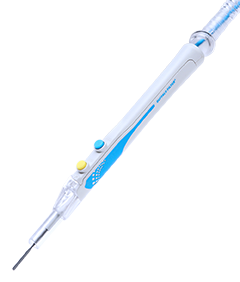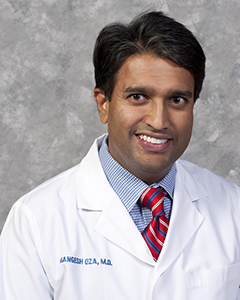NKCH Clears ORs With Smoke-Free Electrosurgical Pencils
May 2, 2019
The device safely and immediately suctions
smoke into an attached tube. Credit: ConMed
Each year, tens of thousands of healthcare workers are exposed to surgical smoke plumes generated by electrosurgical pencils. Water vapor, which comprises 95% of a surgical plume, acts as a carrier by exposing surgeons, nurses, other staff and patients to a combination of more than 150 hazardous chemicals, opens new tab, according to the Association of periOperative Registered Nurses.
North Kansas City Hospital is among a handful of hospitals in the country to make its operating rooms smoke-free by fitting every OR suite with smoke-evacuating electrosurgical pencils.
“As surgeons, we may only be in the OR for two to three hours a day, but hospital nurses and other staff are in the OR for 10-12 hours a day and 40-50 hours a week their entire careers,” said Mangesh D. Oza, MD, FACS, opens new tab, a general surgeon with Meritas Health Comprehensive Surgery, opens new tab. “This is an important initiative to help improve safety for all of us, not just surgeons, but patients and staff as well.”
Risks
Chemicals from surgical smoke, opens new tab include all 16 U.S. Environmental Protection Agency Priority Pollutant polycyclic aromatic hydrocarbons, and potentially expose OR staff to biological contaminants, including aerosolized blood. Intact, viable hepatitis B, HIV and HPV have been recovered in surgical smoke. Inhaling smoke produced when using an electrosurgical device to vaporize 1 gram of tissue is akin to smoking six unfiltered cigarettes in 15 minutes, according to the AORN.
Smoke, which can travel about 40 mph, distributes evenly throughout an OR suite. The AORN reports when surgeons use electrosurgical pencils without smoke-free capabilities, concentration of particles can increase from 60,000 to more than 1 million particles per cubic foot.
“We wear surgical masks, but they’re not filters,” Dr. Oza added. “They don’t prevent us from breathing in smoke.”
The health implications are vast, with perioperative nurses having twice the incidence of many respiratory issues compared with the general public. Those issues include:
- Allergies
- Coughing
- Eye, nose and throat irritation
- Fatigue
- Headaches
- Nausea and/or dizziness
- Respiratory issues
- Runny nose
- Skin irritation
“None of this is mandated, but the AORN has gotten in front of this,” Dr. Oza said. Government agencies such as the Occupational Safety and Health Administration and the Centers for Disease Control and Prevention’s National Institute of Occupational Safety and Health have made some headway by establishing voluntary guidelines. The Joint Commission is also expected to rule on the issue. In the last year, Rhode Island and Colorado enacted surgical smoke evacuation laws.
Selection
NKCH surgeons took part in a months-long trial of several electrosurgical smoke-free pencils, unanimously selecting one with a telescopic feature; locking system; and responsive, multi-directional swivel for unrestricted hand movement. Dr. Oza noted the size of the smoke-free pencil is only 4 mm larger in diameter than the hospital’s previous nonsmoke-free pencil.
The device safely and immediately suctions smoke into an attached tube. A high-efficiency particulate air filter evacuates the smoke, which is treated as biohazard waste when the filter is removed. Scrub techs no longer need to suction surgical smoke at the source, making surgery not only safer but more efficient.
Dr. Oza appreciates that some surgeons may be reluctant to switch from using the former devices. “We recognize it is difficult to change, but at the same time we have to balance this with patient and staff safety,” Dr. Oza added.
Mangesh D. Oza, MD, FACS
 Dr. Oza, opens new tab earned his medical degree from the University of Missouri-Kansas City. He completed his surgery residency at the Alton Ochsner Medical Foundation Hospital
Dr. Oza, opens new tab earned his medical degree from the University of Missouri-Kansas City. He completed his surgery residency at the Alton Ochsner Medical Foundation Hospital